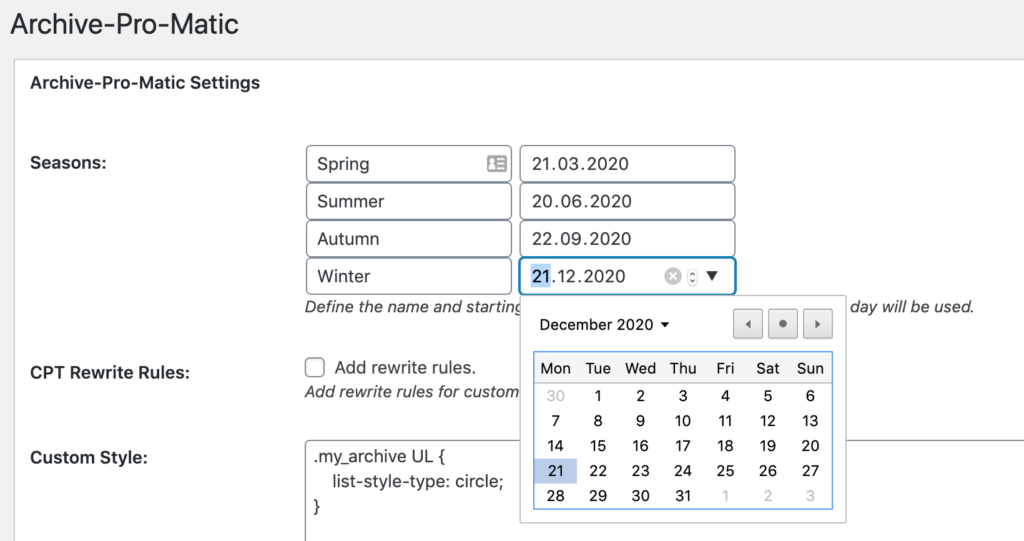This is a test using the ew expand_all and collapse_all callbacks to automatically scroll to the section currently being viewed. The issue is that when expand/collapse all is clicked, large amounts of content is suddenly added to–or removed from–the page. This new page length will often re-flow the page, causing the user to loose their place in the currently viewed content.
The Idea is to implement the following:
1. Create ‘section headers’ that will automatically update when the users scrolls past them.
<h2 id="section-1" class="section">Section Title</h2>
2. Add some javascript that will saved the currently viewed section id to a variable.
jQuery(document).ready(function () {
jQuery(document).on("scroll", onScroll);
var currSection = null;
});
function onScroll(event){
var scrollPos = jQuery(document).scrollTop();
jQuery('.section').each(function () {
var currElement = jQuery(this);
if (currElement.position().top <= scrollPos && currElement.position().top + currElement.height() > scrollPos) {
currSection = currElement.attr("id");
}
});
}
3. After expand/collapse/set all is triggered, all call back will be created that will scroll the page automatically to the section header that was last viewed.
if(typeof currSection !== 'undefined' && jQuery('#' + currSection).length ){
setTimeout(function(){
scrollTarget = jQuery('#' + currSection).offset().top;
if(typeof colomatoffset !== 'undefined'){
scrollTarget = scrollTarget + colomatoffset
}
jQuery('html, body').animate({scrollTop:scrollTarget});
}, 700);
}
Demonstration:
Scroll down a bit and then click the Expand All link placed in the header at the end of the menu. All ‘read more’ content should be expanded and then the page should scroll back to the section that was being viewed. The effect is more dramatic the further down the page is scrolled.
Section 1: Aaeton
Aaeton was a planet of the Aaeton system, in the Core Worlds region. During the Cold War between the Galactic Republic and the Sith Empire, an Imperial bioweapon activated on the planet. During the last days of the Republic, the government of Aaeton had authorization to allow its citizens to visit the generally off-limits neighboring world of Ragoon VI.
more
less
I’m from the planet Aaeton, only half-day’s journey from here. Young people from my planet often go on survival camping trips on Ragoon-6 when we reach fourteen years of age. We have a special allowance from the Senate because we gave the elders of Ragoon refuge when they handed the planet over to the Senate.
―Floria
Section 2: Aaghra
Aaghra was the first planet from the star Zug in the Zug system of the galaxy’s Core Worlds region, not far from Coruscant,[1] the most politically important planet in galactic history.[2] It was a moonless world of molten rock.[1]
more
less
Aaghra was first mentioned briefly in part one of the Planet Hoppers article Aargau: For All Your Banking Needs, which was written by Cory J. Herndon and published on the Wizards.com website in 2003.[1]
Section 3: Aar
Aar was a planet[3] in the Aar system[1] of the Nijune sector,[2] part of the Outer Rim Territories.[1] It was homeworld to the Aar’aa species, reptilian sentients often employed as enforcers by the Hutts, a species known for its many crime lords.[3]
more
less
Aar was first mentioned in the 1997 novel The Paradise Snare, written by A. C. Crispin, and was also mentioned eleven years later in the 2008 The Complete Star Wars Encyclopedia.
Section 4: Aargau
Aargau (pronounced /är-‘gou/)[5] was a planet in the Zug system of the Core Worlds region, not far from Coruscant and the Corellian Run. It was run by and served as the headquarters for the Bank of Aargau, which was part of the InterGalactic Banking Clan. Numerous other banks and corporations were also based on Aargau, including the Z-Gomot Ternbuell Guppat Corporation. Aargau was an exceptionally wealthy world, due both to its status as a financial center, as well as the planet’s vast reserves of rare and precious metals.
more
less
Aargau was a member of the Galactic Republic from its discovery until the end of that galactic power. After the fall of the Galactic Empire, it was considered a New Republic stronghold. The region of space occupied by the planet would later fall under the hegemony of first the Galactic Federation of Free Alliances, and then subsequently Darth Krayt’s Galactic Empire. Despite this, Aargau took a neutral approach to politics, which meant that warring factions were mutually welcome to conduct business on the planet. The planetary government imposed only three laws on citizens and visitors, called the Three Statutes of Aargau. These laws focused on the export of Aargau’s natural resources, the absolute ban on weapons for visitors—and, conversely, the requirement to bear arms for Aargauuns—as well as maintaining the integrity of the Bank of Aargau. Breaking any of these rules was punishable by immediate execution.
Section 5: Aargonar
Aargonar was a dusty, desert-climate planet located in the Borderland Regions of the Mid Rim.
more
less
Aargonar was an insignificant desert world with few population.[2] The terrain was reminiscent of Tatooine for Jedi Knight Anakin Skywalker, with rock arches and stone spires dotting the once watery-planet.[3] The planet had several moons, including Aargonar 3.[2]
The planet was known to house numerous Sarlacc.[2] It was also home to Hrumphs and Gouka dragons.[3]



